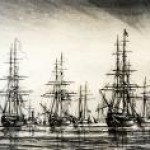FL Div Hist Res
Submarine Base
Following World War I, the Naval Station transformed the waters inside of the Outer Mole Pier into a submarine training base. Five metal “finger†docks were built to service submarines. During World War II, German U-boats sank 49 ships off the coast of Florida. The primary role of submarines stationed here during World War II was the destruction of enemy ships and protection of Allied supply convoys in the Atlantic. The base was decommissioned in 1974 as nuclear submarines replaced diesel powered ones.
1846 Havana Hurricane
On October 11, 1846, the worst hurricane in local memory struck. The storm surge flooded the streets with up to eight feet of water accompanied by Category 4 winds. The light house and all but six of the city’s six hundred buildings were damaged, destroyed or floated out to sea. Sixty people drowned and many of the survivors escaped by clinging to bushes and trees on high ground at Solaris Hill. In less than a decade following the hurricane Key West’s population increased 300%.
The Mosquito Fleet
By the end of 1822, mere months after the first US flag was planted in Key West, Commodore David Porter was sent to take charge. Porter commanded the West Indian Squadron nicknamed the “Mosquito Fleetâ€. Porter was ordered to end the reign of “The Brethren of the Coast,†the original pirates of the Caribbean. With the help of the Sea Gull, the first steam powered ship in the US Navy, Porter’s efforts are credited with eliminating piracy in the Caribbean.
St. Mary Star of the Sea
Welcome to the oldest Roman Catholic Parish in South Florida. There is evidence that Spanish Jesuits serving in Cuba attempted to establish a mission in Key West as early as 1724. The first Catholic Church on the island was dedicated February 26, 1852. It was destroyed by a fire in 1901. The current church building was dedicated to Saint Mary Star of the Sea by the Bishop of St. Augustine in August of 1905.
Mansard Roof
This mansard roof, also referred to as a French roof, was popularized by the French architect, Francois Mansart, during the 1600s. Primarily designed to shed snow loads and avoid French property tax, it became popular in the 1850s throughout the U.S. and Canada in an architectural movement known as “Second Empire Style.†Mansard roofing in Key West can be attributed to the international influences of the city’s diverse population in the nineteenth century.




